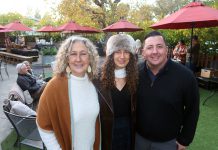False Spring
February often brings a “false” spring to Sonoma County. The warmth of the sun and the fresh smell of moist soil stir our gardening passions and we want to plant things! You may even find tomato starts in the nurseries; resist the temptation — it’s not time yet!
You can, however, still plant wildflower seeds, and perennials and shrubs. Salvias, yarrows, manzanitas, ceanothus, mock orange, twinberry, currants, all our wonderful California native plants, can be planted and still count on plenty of rain to fall. But if it doesn’t, keep them moist until the end of the rainy season.
Mulch is always important with new plantings. After you water them in, mulch around, but not touching the stem, and the mulch should be about two inches deep. A good organic compost is the best.
We have had lots of cold and frost and will have some yet. So do not prune off dead-looking branches and twigs. They protect the living portion even if they appear dead, they may not be, so wait for the “real” spring.
By now, the tops of yarrow and some of the salvias, for instance, are truly dead, and the new green shoots are appearing at the base of the plant. You could clip the dead matter at the top, but I tend to leave it for another month or so. There may be seeds the birds can use, there may be insect eggs waiting to hatch. Even if you put in the compost, they are not as available to wildlife. There is no real downside to waiting until March or April. I find that all sorts of critters may use the debris.
Propagation can be done this month. Cuttings can be made from coyote bush (Baccharis pilularis), twinberry (Lonicera involucrata), coffeeberry (Rhamnus californica), some salvias, and many more.
Cut the tips from healthy shrubs, including several nodes (where the leaves would appear), maybe three to six inches long. Remove the leaves along the stem, and if there are many at the tip, remove most of them. Dip the cuttings a couple of inches in a rooting hormone powder. They can then be inserted into a rooting medium such as a mixture of sand and vermiculite or perlite.
Keep your new babies moist; you can put a sheet of plastic wrap over the top of the cuttings to help keep in the moisture. Set them in filtered shade until you see new growth appear, probably two months. They can then be repotted into a pot with soil. They will not all live through the process; getting several would be a wonderful thing!
Check your garden often to see what is in bloom and watch to see what pollinators are visiting; then plant more of that. Pollinators suffer at this time of year, looking for sources of food. Winter blooming manzanitas are important for hummingbirds and insects.
If the weather persists in being crummy, plan a weekend trip to one of our Bay Area botanical gardens. The East Bay and San Francisco are great choices. Strybing Arboretum in SF, UC’s Botanical Garden in Berkeley, and SF Botanical Garden are delightful at any time of year. You may get some great ideas for native plants and how to show them off.
The California Native Plant Society’s February meeting is on Tuesday, February 19, at 7:30 p.m. As usual, it’s at the Luther Burbank Art & Garden Center, 2050 Yulupa Avenue, Santa Rosa. The speaker this month is Susan Harrison, an ecologist from Sonoma who has been on the UC Davis faculty since 1991. She will talk on the endemic-rich floras of serpentine soils. She is co-editor of “Serpentine: Evolution and Ecology of a Model System.” Her lab website is: www.des.ucdavis.edu/faculty/Harrison/.
Please write me at: jo*******@*****st.net.








